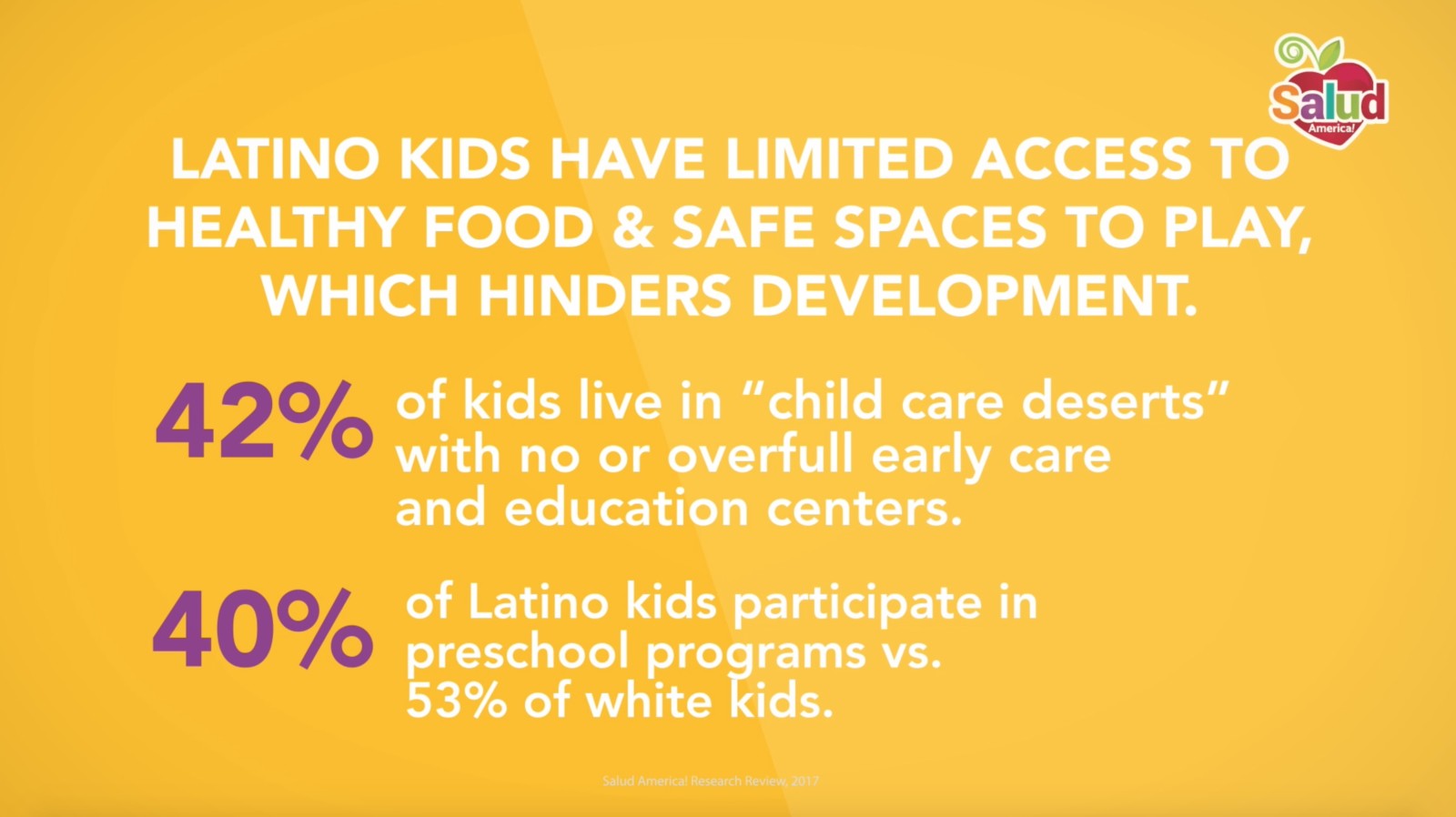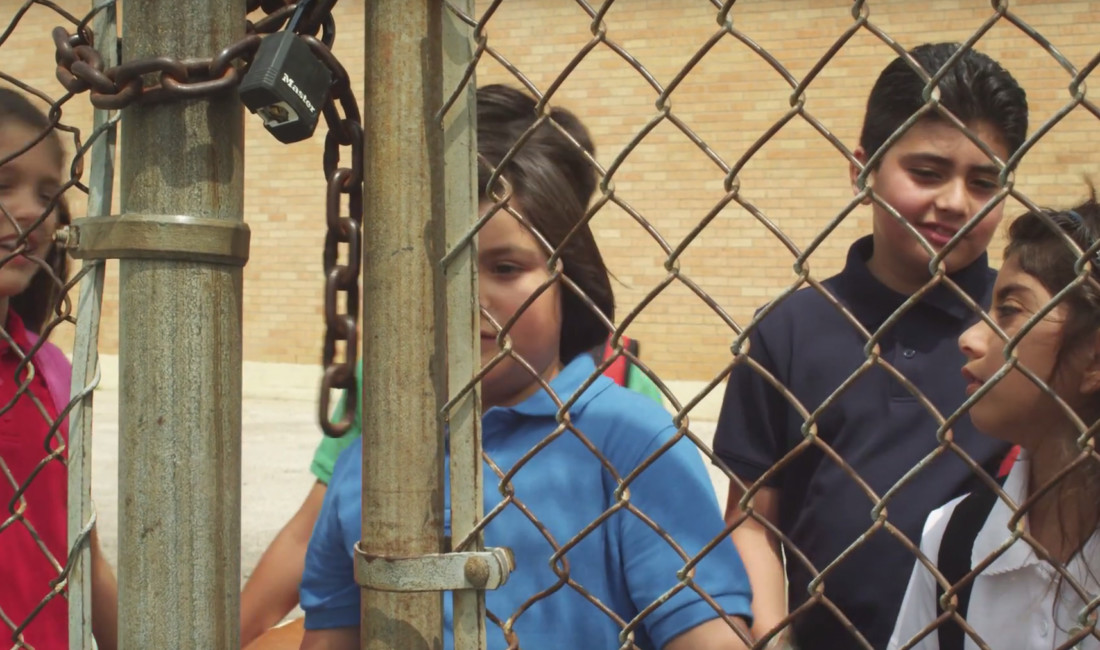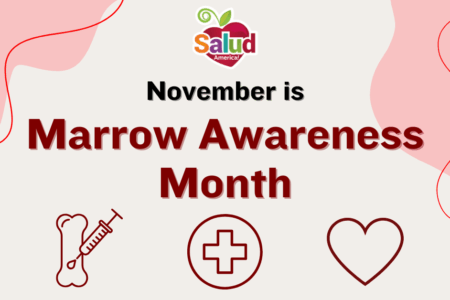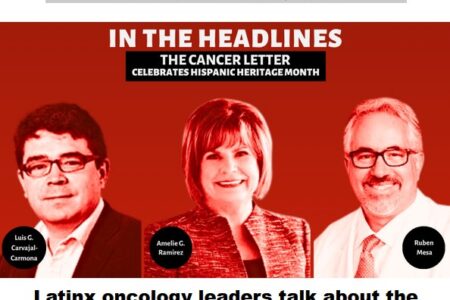
Share On Social!
This is part of the Salud America! The State of Latino Early Childhood Development: A Research Review »
Latino Kids Have Limited Access to Healthy Foods
Pediatric obesity is an important public health issue.
Targeted efforts to curb child obesity rates are necessary, especially among Latino children, as this sub-group is more likely to become overweight before entering elementary school than children of other ethnic groups.11 Obesity in Latino children increases health risk factors and can also impact school performance.11,54
A main contributor of overweight and obesity in Latino children may be their limited access to healthy food. See the full Salud America! research review on Latino children and healthy food access.10
Some recent study results appear mixed on this issue.
 Although fast-food consumption does occur in Latino children, one study found that their caloric intake from fast food was comparable or lower than in other racial and ethnic groups, except for Asians.55 Another study found that soda and unhealthy snacks were commonly available in Latino households, but so were fresh fruits and vegetables, and Latino preschool children also consumed fruits and vegetables more frequently than black children.56 These findings are somewhat contrary to those of another study of primarily Latino and black children living in rural, low-income families in the Southeast US that found lower consumption of fruits among Latinos compared with black children.57
Although fast-food consumption does occur in Latino children, one study found that their caloric intake from fast food was comparable or lower than in other racial and ethnic groups, except for Asians.55 Another study found that soda and unhealthy snacks were commonly available in Latino households, but so were fresh fruits and vegetables, and Latino preschool children also consumed fruits and vegetables more frequently than black children.56 These findings are somewhat contrary to those of another study of primarily Latino and black children living in rural, low-income families in the Southeast US that found lower consumption of fruits among Latinos compared with black children.57
Many factors appear to contribute to intake of fruits and vegetables, as another study of older Latino children (ages 10-14) found that few of the participating children (N = 181) met the dietary recommendations regard fruit and vegetable consumption and other nutritious food.58 Access to culturally-relevant healthy foods is also a factor. In a study of grocery stores in Latino and black neighborhoods, most stores carried fewer than 50% of fruits and vegetables that were considered culturally specific and commonly eaten by these populations.59 Poverty and food insecurity may play a contributing role as well,60 as may parenting issues such as stress and depression that may affect parental feeding practices.61
Other issues such as cultural beliefs may influence the types of foods eaten. Many Latinos believe they are lactose-intolerant and often avoid dairy products to reinforce this belief; however, this culturally-specific eating preference may lead to deficiencies in micronutrients such as calcium, potassium, and vitamin D. Optimal levels of these micronutrients are thought to reduce the risk of heart disease, metabolic syndrome, and type 2 diabetes.62
Improving Access to Healthy Foods Can Improve Latino Development
Because poor nutrition and obesity in Latino children is due to complex sociocultural reasons, a broad approach to improving eating habits may be effective, especially when it includes extended family networks, school, and community activities.63
Addressing parent feeding practices is necessary to empower Latino parents to offer healthier food choices at meal times and snacks in the home environment. Parents should be encouraged to eat family meals together to model healthy eating habits and to avoid TV during meals.56
Early care and education (ECE) is an emerging setting for obesity-prevention via healthy lifestyles. The use of ECE facilities—including child care centers, day care homes, Head Start programs, preschool and pre-kindergarten programs—has become a norm in the U.S.64
A successful program, Color Me Healthy, demonstrated positive health outcomes in young children as they learned about healthy eating and exercise in active ways, including interaction with peers and parents. Additional programs that have been successful include Brocodile the Crocodile, Eat Well Play Hard, and Hip Hop to Health, Jr.65 Any program implemented, however, should be modified as needed for cultural relevancy.63
Several organizations play a central role in improving healthy eating in Latino children, including schools, WIC, Head Start early child care programs, and churches. Community programs are also effective. LA Sprouts, a 12-week hands-on nutrition/cooking and gardening curriculum was pilot-tested with 104 Latino children (59% obese), with a control group, to increase knowledge and skills on gardening, nutrition, and cooking.66 The curriculum was developed to be culturally- and age-appropriate for urban, Latino upper elementary children. At the end of the pilot test, intervention children had significantly lower diastolic blood pressure and greater fiber intake compared with controls; those who were overweight at baseline also had decreases in BMI and weight gain compared with controls who were overweight.
Another pilot study (led by a Salud America! grantee) tested a community-based garden, nutrition, and cooking program, Growing Healthy Kids, with a 60-percent Latino cohort of 120 children and their families. The study found that 17% of overweight/obese children achieved an improved BMI classification. According to parents’ reports, children ate two more servings of fruit per week and almost five more servings of vegetables per week.
At the federal level, funding is allocated to schools to offer healthy breakfasts and lunches to children who are on free or reduced meals, in which Latinos are more likely to qualify for than white children. States with stronger nutrition standards are better able to reduce obesity among children in free and reduced lunch programs. More innovative programs to improve nutrition in schools include better vending machine choices and more nutritious a la carte items.67
Other federally-funded programs—such as Supplemental Nutrition Assistance Program (SNAP), Supplemental Nutrition Program for Women, Infants, and Children (WIC), Summer Food Service, Head Start, and Child and Adult Care Food Program (CACFP)—may also help to improve nutrition and access to healthy food in Latino children (see https://www.nutrition.gov/food-assistance-programs for more information);68 importantly, however, undocumented immigrant Latinos would not qualify for these programs and may need help from other sources, such as emergency food assistance programs.69
Latino Kids Have Limited Access to Active Spaces
Many studies have found that U.S. Latino children have inadequate access to active spaces, such as trails, parks, and recreation facilities.70–75
 One study of three diverse U.S. regions found that only 19 percent of Latino neighborhoods had recreational facilities, compared with 62 percent of white neighborhoods.76
One study of three diverse U.S. regions found that only 19 percent of Latino neighborhoods had recreational facilities, compared with 62 percent of white neighborhoods.76
Similar results were found when looking specifically at neighborhood socioeconomic level, where children of racial/ethnic minorities living in poverty had less access to active spaces than children living in more advantaged neighborhoods.77 Interestingly, national data found that Latino neighborhoods were actually closer to parks but farther from green spaces than non-Latino neighborhoods,78 so more research may be needed to determine if and how the type of active space influences physical activity levels.
Inadequate access to physical activity sites has been linked to low levels of physical activity among Latino children.79,80 In one study of children (66% Latino) living in East Harlem, NY, nearly 80 percent of the Latino participants had no access to active spaces, and those living in areas with fewer active sites spent less time engaging in physical activity. Therefore, increasing access to active spaces in underserved areas may help to promote physical activity among youth living there.79,81,82
Improving Access to Active Spaces Can Improve Health, Wellbeing
The Healthy People initiative developed by the U.S. Department of Health and Human Services aims to increase youth access to active spaces by improving the built environment (e.g., adding sidewalks, bike lanes, trails, and parks) and increasing access to physical activity facilities.83 Other initiatives are underway in a number of U.S. cities, many of which have predominantly Latino communities.
- shared and open use policies, where schools and other entities partner to share school recreational facilities with the public;
- outdoor learning environments or green schoolyards, where early care facilities and schools include gardens and natural elements in the playscape;
- Open Streets programs, where streets are closed to motorized traffic allowing for safe use by residents for walking, bike riding, etc;
- “rails-to-trails” projects, where inactive railroad tracks are converted into bike paths and parks in a number of U.S. cities;
- opens space plans, which aim to improve access to trails and green space;
- Complete Streets policies, which call for roadways to be safe and convenient for people of all ages, whether walking, biking, driving, or riding transit;
- Vision Zero strategies,84 which aim to eliminate traffic fatalities and serious injuries;
- and other initiatives.71,85–90
The design and development of communities can make it easier or more difficult for families to be active on a daily basis. The National Physical Activity Plan highlights several methods to increase families’ opportunities for incidental physical activity:91
- Effective land use policies can put common destinations with walking and biking connections near where families live, to increase active transportation as well as access to vital community services.
- Community planners can integrate considerations for non-motorized travel and public health into formalized planning processes, such as master plans, comprehensive plans, zoning code updates, housing and commercial developments, metropolitan planning organizations’ (MPO) transportation improvement project lists, trail plans, and regional transportation plans, with specific focus on improving environments in low-income communities.
- Transportation spending can be reformed to tie it to larger goals for health, safety, equity, and the environment—rather than to a focus only on traffic volumes and speeds.
The Role of Healthcare Providers in Promoting Physical Activity
There is little research on how effective physical activity counseling and prescriptions are to increase physical activity levels among Latinos, but some studies show that asking patients about physical activities levels is associated with weight loss, improved glucose control in diabetic patients and increased physical activity among cancer survivors.92
Additionally, physicians who are physically active themselves are more likely to counsel more frequently and more effectively about the importance of physical activity to their patients.93,94
The National Physical Activity Plan highlights the need for healthcare systems to integrate physical activity as a patient “vital sign” into electronic health records for all healthcare providers to assess and discuss physical activity with their patients.91,92 Tobacco use, for example, was adopted as a vital sign 60 years ago. After smoking, physical inactivity is the leading risk factor for predicting if a person will die early.95
Healthcare systems should also support the capacity of school-based health clinics and early learning programs to promote physical activity. Additionally, schools, childcare centers, and early childhood facilities can adopt standards to ensure children are appropriately physically active and to develop outdoor learning models to integrate physical activity, natural settings, and education.
See the full Salud America! research review on Latino children and active spaces.89
More from our The State of Latino Early Childhood Development: A Research Review »
- Introduction & Methods
- Key Research Finding: Latino Childhood Trauma
- Key Research Finding: Healthy Lifestyles
- Key Research Finding: Early Care and Education
- Key Research Finding: Strategy—Improve Early Care
- Key Research Finding: Strategy—Boost School Readiness
- Key Research Finding: Strategy—Reduce Childhood Trauma
- Key Research Finding: Strategy—Incorporate Family Values
- Key Research Finding: Strategy—Support Moms
- Policy Implications
- Future Research Needs
References for this section »
10. Perry, A., Patlak, M., Ramirez, A. G. & Gallion, K., J. Making Healthy Food and Beverages the Affordable, Available, Desired Choices Among Latino Families. (2015).
11. Liu, G. C., Hannon, T., Qi, R., Downs, S. M. & Marrero, D. G. The obesity epidemic in children: Latino children are disproportionately affected at younger ages. Int. J. Pediatr. Adolesc. Med. 2, 12–18 (2015).
54. Hollar, D. et al. Effect of a Two-Year Obesity Prevention Intervention on Percentile Changes in Body Mass Index and Academic Performance in Low-Income Elementary School Children. Am. J. Public Health 100, 646–653 (2010).
55. Vikraman, S., Fryar, C. D. & Ogden, C. L. Caloric intake from fast food among children and adolescents in the United States, 2011-2012. NCHS Data Brief (2012).
56. Skala, K. et al. Ethnic Differences in the Home Food Environment and Parental Food Practices Among Families of Low-Income Hispanic and African-American Preschoolers. J. Immigr. Minor. Health 14, 1014–1022 (2012).
57. Amuta, A. O., Jacobs, W., Idoko, E. E., Barry, A. E. & McKyer, E. L. J. Influence of the Home Food Environment on Children’s Fruit and Vegetable Consumption: A Study of Rural Low-Income Families. Health Promot. Pract. 16, 689–698 (2015).
58. Santiago-Torres, M., Adams, A. K., Carrel, A. L., LaRowe, T. L. & Schoeller, D. A. Home Food Availability, Parental Dietary Intake, and Familial Eating Habits Influence the Diet Quality of Urban Hispanic Children. Child. Obes. 10, 408–415 (2014).
59. Grigsby-Toussaint, D. S., Zenk, S. N., Odoms-Young, A., Ruggiero, L. & Moise, I. Availability of Commonly Consumed and Culturally Specific Fruits and Vegetables in African-American and Latino Neighborhoods. J. Am. Diet. Assoc. 110, 746–752 (2010).
60. Asfour, L. et al. Ethnicity, Household Food Security, and Nutrition and Activity Patterns in Families With Preschool Children. J. Nutr. Educ. Behav. 47, 498–505.e1 (2015).
61. Hughes, S. O., Power, T. G., Liu, Y., Sharp, C. & Nicklas, T. A. Parent emotional distress and feeding styles in low-income families. The role of parent depression and parenting stress. Appetite 92, 337–342 (2015).
62. Brown-Riggs, C. Nutrition and Health Disparities: The Role of Dairy in Improving Minority Health Outcomes. Int. J. Environ. Res. Public. Health 13, 28 (2015).
63. Bandy, T. & Moore, K., A. What Works for Latino/Hispanic Children and Adolescents: Lessons from Experimental Evaluations of Programs and Interventions – Child_Trends-2011_02_01_RB_WW4LatinoChildren.pdf. childtrends.org (2011). Available at: https://www.childtrends.org/wp-content/uploads/2011/02/Child_Trends-2011_02_01_RB_WW4LatinoChildren.pdf. (Accessed: 31st July 2017)
64. National Center for Education Statistics. Early Childhood Program Participation Survey of the National Household Education Surveys Program (ECPP-NHES:2005). (2005). Available at: https://nces.ed.gov/programs/digest/d09/tables/dt09_044.asp. (Accessed: 1st August 2017)
65. Foltz, J. L. et al. Population-Level Intervention Strategies and Examples for Obesity Prevention in Children. Annu. Rev. Nutr. 32, 391–415 (2012).
66. Davis, J. N., Ventura, E. E., Cook, L. T., Gyllenhammer, L. E. & Gatto, N. M. LA Sprouts: A Gardening, Nutrition, and Cooking Intervention for Latino Youth Improves Diet and Reduces Obesity. J. Am. Diet. Assoc. 111, 1224–1230 (2011).
67. National Council of La Raza. An Essential Investment in the Health of Latino Children. (2016). Available at: http://www.afabc.org/wp-content/uploads/2016/09/childhoodnutrition_reauthorization_12016.pdf. (Accessed: 25th January 2017)
68. Food Assistance Programs | Nutrition.gov. Nutrition.gov (2017). Available at: https://www.nutrition.gov/subject/food-assistance-programs. (Accessed: 9th August 2017)
69. Martinez-Schiferl, M. & Zedlewski, S. R. Emergency food assistance helps many low-income hispanic children. (Urban Institute, 2010).
70. Babey, S. H., Hastert, T. A. & Brown, E. R. Teens living in disadvantaged neighborhoods lack access to parks and get less physical activity. UCLA Cent. Health Policy Res. (2007).
71. Gomez-Feliciano, L. et al. Active Living Logan Square: joining together to create opportunities for physical activity. Am. J. Prev. Med. 37, S361–S367 (2009).
72. Gordon-Larsen, P., Nelson, M. C., Page, P. & Popkin, B. M. Inequality in the Built Environment Underlies Key Health Disparities in Physical Activity and Obesity. Pediatrics 117, 417–424 (2006).
73. Kamel, A. A., Ford, P. B. & Kaczynski, A. T. Disparities in park availability, features, and characteristics by social determinants of health within a U.S.–Mexico border urban area. Prev. Med. 69, S111–S113 (2014).
74. Powell, L. M., Slater, S., Chaloupka, F. J. & Harper, D. Availability of Physical Activity–Related Facilities and Neighborhood Demographic and Socioeconomic Characteristics: A National Study. Am. J. Public Health 96, 1676–1680 (2006).
75. Wilson, D. K., Kirtland, K. A., Ainsworth, B. E. & Addy, C. L. Socioeconomic status and perceptions of access and safety for physical activity. Ann. Behav. Med. 28, 20–28 (2004).
76. Moore, L. V., Diez Roux, A. V., Evenson, K. R., McGinn, A. P. & Brines, S. J. Availability of Recreational Resources in Minority and Low Socioeconomic Status Areas. Am. J. Prev. Med. 34, 16–22 (2008).
77. Garcia, R. & Strongin, S. Healthy parks, schools and communities: mapping green access and equity for Southern California. The City Project Web Site (2011). Available at: http://www.mapjustice.org/images/Southern_California_Report_FInal_Medium_Res.2.pdf. (Accessed: 12th June 2017)
78. Wen, M., Zhang, X., Harris, C. D., Holt, J. B. & Croft, J. B. Spatial Disparities in the Distribution of Parks and Green Spaces in the USA. Ann. Behav. Med. 45, 18–27 (2013).
79. Galvez, M. P. et al. Associations Between Neighborhood Resources and Physical Activity in Inner-City Minority Children. Acad. Pediatr. 13, 20–26 (2013).
80. Spengler, J. Promoting physical activity through the shared use of school and community recreational resources. (Active Living Research, 2012).
81. Cohen, D. A. et al. Use of neighbourhood parks: does socio-economic status matter? A four-city study. Public Health 127, 325–332 (2013).
82. Rundle, A. et al. Associations between Body Mass Index and Park Proximity, Size, Cleanliness, and Recreational Facilities. Am. J. Health Promot. 27, 262–269 (2013).
83. Office of Disease Prevention and Health Promotion. Healthy People 2020. (2017). Available at: https://www.healthypeople.gov/. (Accessed: 12th June 2017)
84. Shahum, L. Safe Streets: Insights on Vision Zero Policies From European Cities. (The German Marshall Fund of the United States, 2017).
85. Logan Square Neighborhood Association. Designing the Bloomingdale Trail Event (10/4/11). (2012). Available at: http://www.lsna.net/Issues-and-programs/Health/Youth-Create-Visions-of-New-Bloomingdale-Trail/Designing-the-Bloomingdale-Trail-Event-10-4-11-.html. (Accessed: 12th June 2017)
86. Miami Dade County. Parks and Open Space Master Plan. Available at: http://www.miamidade.gov/parksmasterplan/. (Accessed: 1st August 2017)
87. National Recreation and Park Association. Parks & Recreation in Underserved Areas: A Public Health Perspective. Available at: http://www.nrpa.org/uploadedFiles/nrpa.org/Publications_and_Research/Research/Papers/Parks-Rec-Underserved-Areas.pdf. (Accessed: 12th June 2017)
88. Open Streets MPLS. Open Streets MPLS. Open Streets Available at: http://www.openstreetsmpls.org/. (Accessed: 12th June 2017)
89. Swanson, J., Ramirez, A. G. & Gallion, K. J. Making Physical Activity a Daily Experience for Latino Youth. (2016).
90. The Trust for Public Land. The 606. The 606 (2015). Available at: http://www.the606.org/. (Accessed: 12th June 2017)
91. National Physical Activity Plan Alliance. National Physical Activity Plan. (2016). Available at: http://physicalactivityplan.org/docs/2016NPAP_Finalforwebsite.pdf. (Accessed: 25th October 2017)
92. Grant, R. W., Schmittdiel, J. A., Neugebauer, R. S., Uratsu, C. S. & Sternfeld, B. Exercise as a Vital Sign: A Quasi-Experimental Analysis of a Health System Intervention to Collect Patient-Reported Exercise Levels. J. Gen. Intern. Med. 29, 341–348 (2014).
93. Lobelo, F. & de Quevedo, I. G. The Evidence in Support of Physicians and Health Care Providers as Physical Activity Role Models. Am. J. Lifestyle Med. 10, 36–52 (2016).
94. Tarasenko, Y. N., Miller, E. A., Chen, C. & Schoenberg, N. E. Physical activity levels and counseling by health care providers in cancer survivors. Prev. Med. 99, 211–217 (2017).
95. Booth, F. W., Roberts, C. K. & Laye, M. J. Lack of exercise is a major cause of chronic diseases. Compr. Physiol. 2, 1143–1211 (2012).
By The Numbers
142
Percent
Expected rise in Latino cancer cases in coming years




